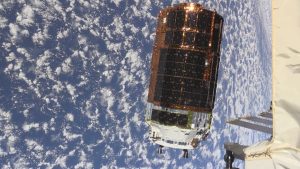
A JAXA H-2B rocket launched the HTV-9 mission (aka Kounotori 9) on Wednesday, May 20, 2020, at 5:31 PM (UTC).
The mission patch is a gold ring around a blue and yellow graphic of the HTV capsule with a yellow image of the ISS in the distance against a black background. The text “H-II Transfer Vehicle” and mission designation “HTV9” are in the yellow ring. The Japanese characters (こうのとり9号機) say “Kounotori 9”.
It was a 2-stage rocket with liquid fuel for the stages and solid fuel for the boosters. The fuel consisted of oxygen and hydrogen.
This was the last H-2B; the first flight of the new H3 is planned for later this year. This was also the last Kounotori. A new Japanese cargo vessel is expected to launch in 2022.
A lot of cargo went to the ISS on HTV-9 — 6200 kilograms to be exact (4300 kg in the pressurized compartment and 1900 kg in the unpressurized compartment) — including a solid combustion experimental module; the module will continue research on combustion in microgravity. Also on board were 6 new lithium-ion batteries for the space station and fresh bell peppers, kiwi, and citrus fruits for the crew.
One of the other experiments was a Wireless LAN Demonstration, or WLD (pronounced wild). WLD was an experiment that was performed during Kounotori 9’s flight. During the test, a video taken by Kounotori 9 was broadcast in real-time onboard the space station, via a wireless LAN (WLAN) datalink. The experiment was conducted during Kounotori 9’s approach, departure, and while berthed to the ISS. For WLD, the spacecraft has a camera attached to its propulsion module, while a data processor and WLAN antenna is located at the Unpressurized Logistics Carrier’s aperture. The technology tested by WLD will enable ISS crews to monitor approaching vehicles during an autonomous docking. This will be the first time for two spacecraft to communicate using WLAN during a rendezvous.




 Join the Crew!
Join the Crew!
 Escape Velocity Space News
Escape Velocity Space News
0 Comments